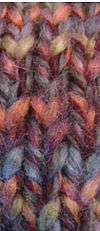List of yarns for crochet and knitting
Yarn size
Depending on the exact yarn weight and the gauge of the knitter or crocheter and how tight or loose the yarn is held, the gauge listed below can vary. For this reason it is important to check the gauge of the pattern being used to be sure so the finished project is the desired size. Most patterns have a listed gauge to create an item of the size(s) indicated in the pattern.
| Category name |
Symbol |
Description |
Crochet gauge[1] |
Hook size |
Knitting gauge |
Needle size |
|---|
| Lace |
|
fingering, crochet 10-count thread |
33 - 40 sts |
1.5mm - 2.25 mm |
|
|
| Super fine |
|
sock, fingering, baby |
21 - 32 sts |
2.25mm - 3.5 mm |
|
|
| Fine |
|
sport, baby |
16 - 20 sts |
3.5mm - 4.5 mm |
|
|
| Light |
|
DK, light worsted |
12 - 17 sts |
4.5mm - 5.5 mm |
|
|
| Medium |
|
worsted, Afghan, Aran |
11 - 14 sts |
5.5mm - 6.5 mm |
|
|
| Bulky |
|
chunky, craft, rug |
8 - 11 sts |
6.5mm - 9 mm |
|
|
| Super Bulky |
|
bulky, roving |
5 - 9 sts |
9mm & larger |
|
|
Terminology
Common terms used to describe knitting and crochet yarn properties.
| Term |
Description |
|---|
| Absorbency |
The ability of a fiber to hold water, determines sweat absorption and suitability for warm weather wear. |
| Breathability |
How readily air passes through the fiber. |
| Dyeability |
How well the fiber accepts and holds color. |
| Hand/Handle |
Tactile description: softness, resiliency, etc. |
| Loft |
The amount of air between fibers. |
| Resiliency (elasticity) |
The tendency of a fiber to resume its original shape after stretching. |
| Thickness |
The diameter of the fiber in micrometres. |
Fiber type
Plant based
Cottons
All varieties of cotton have a dull finish unless mercerized. Cotton yarn has minimal elasticity unless blended with other fibers. Pure cotton is useful for projects that require structure such as purses and tote bags, placemats, and other utilitarian items.
| Fiber type |
Description |
|---|
| Egyptian cotton |
Longest cotton fiber, smoother and softer than other cottons. |
| Pima cotton |
Cross between Egyptian and American cottons. Intermediate properties. |
| American cotton |
Medium-long fiber, readily takes on dye. Available in widest variety of colors. |
Other plant fibers
| Fiber type |
Description |
|---|
| Linen |
Strong fiber, good for warm weather items. Wrinkles easily. |
| Bamboo bast |
Similar to ramie, possesses an elegant sheen. Not to be confused with the more common bamboo rayon. |
Animal based fibers
| Fiber type |
Description |
|---|
| Merino wool |
Softer than cotton, tends to pill. |
| Icelandic wool |
Strong but scratchy. |
| Mohair |
Lofty and luxurious, best used as an outer layer. May feel scratchy. |
| Cashmere |
Soft, luxurious, expensive. |
| Alpaca |
Very warm. Suitable for accessories such as scarves. |
| Angora |
Very soft, tends to shed. Best used in pure form as an accent material, or blended with other fibers. |
| Silk |
Exceptionally strong, lustrous, and shiny. Good for summer wear. |
Synthetics
| Fiber type |
Description |
|---|
| Acrylic |
Washes well, inexpensive. Good choice for beginners and for items designed for babies or pets. |
| Nylon |
Strong, elastic, washes well. Not ideal for garments unless blended with other fibers. |
| Rayon |
Made from processed cellulose (e.g. wood pulp, bamboo, seaweed) extruded into threads. Inexpensive and highly absorbent, natural sheen. |
Notes
- ↑ Estimated, single crochet 4". Stoller, p. 24.
References
- Debbie Stoller, Stitch 'N Bitch Crochet: The Happy Hooker New York: Workman Publishing, 2006.
- Edie Eckman, The Crochet Answer Book, North Adams, Massachesetts: Storey Publishing, 2005.
|
|---|
|
| Tools | | |
|---|
|
Techniques
and motifs | |
|---|
|
| Items | |
|---|
|
| Crocheted lace | |
|---|
|
| Related | |
|---|
|
|---|
|
| Tools and materials | | |
|---|
|
| Yarn styles | |
|---|
|
| Yarn brands | |
|---|
|
| Styles | |
|---|
|
| Stitches | |
|---|
|
| Techniques | |
|---|
|
| Patterns | |
|---|
|
| Machine knitting | |
|---|
|
Knitters and
designers | |
|---|
|
| Organizations | |
|---|
|
| Related | |
|---|

